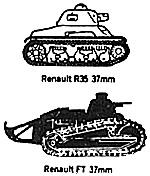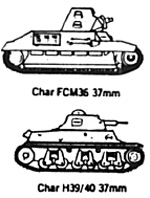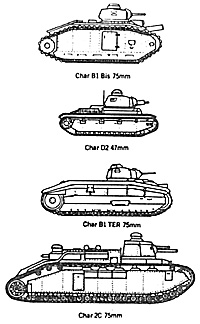
The most numerous of the French tanks were the light tanks, chars legers, intended for the close support of infantry. This class included four series, the oldest of which was the char leger Renault FT modele 1Z The FT was the standard French infantry support tank in World War I. Of the more than 3,000 produced, 1,560 remained in French service in 1940. The FTwas lightly armored and armed with either an 8mm Hotchkiss machinegun or a short barrelled 37mm SA 18 cannon (Table 1). From 1931 on most mach inegun armed FTs were ref itted with 7.5mm modele 1931 machineguns. Some FTs received engine and suspension modifications in the late 1930's to increase the range and speed.
Thirtynine Renault BSs, FTs mounting a short 75mm gun, were also available. In May 1940, 534 FTs were assigned to eight Bataillons Oryaniques and three Compagnies Autonomes deployed in France (Table 2). An additional 196, including most of the BSs were assigned to units in North Africa, and 56 to a bataillon in Syria. Small numbers were assigned to other colonies, while hundreds more were held in reserve.
Because so many FTs were available after World War I, tank development had very low priority in the 1920's. Many vehicles were tested, but none were accepted for large scale production. During these years only the infantry was authorized to use chars-tanks. The cavalry used automitrailleuses-wheeled, half or fully-tracked machinegun carriers. This separation was the style in other armies of the time, including the U.S. Army.
In 1933, in response to the beginning of rearmament in Germany, the French Army called for a new char leger to replace the aging FT. Designs were submitted by Renault, Hotchkiss and FCM. In April 1935, after extensive tests of the prototypes, the Renault was accepted as the new standard infantry tank, char leger modele 1935 R (Renault 35) or R-35. The Renault featured a hull made up of several large castings and a turret designed by the arsenal Atefiers de Puteaux (APX). APX turrets were used on most French tanks. Most R-35 were armed with a 7.5 machinegun and an updated version of the short 37mm gun carried by the FT, either a 37 SA 180 or a 37 SA 18 M37. Some late production vehicles received long-barrelled 37 SA 38 cannon (Table 1). In 1939 some were produced with unditching tails to improve trench crossing capability. These were designated R-39. From February 1940, radios were fitted to some R35s and 39s during production. Otherwise throughout its production the basic R35 was unchanged.
In service the R-35 suffered from suspension problems and a very short range. AMX (Atelier de Construction d'Issy-les Moulineaux) was assigned to correct these faults, the resulting vehicle being designated R40. Some of these received the 37 SA 38, radio and tail of the late R-35. Altogether nearly 200OR35 series were produced makingit the mostnumerous of the French tanks. Over 100 of these were R40s.
Twenty-four Bataillons Organiques were equipped with the R-35 series in France in May 1940, including two equipped with R40s (Table 2). One bataillon in Morocco, and two in Syria were also equipped with R-35s. In addition, 285 R35s were exported before May 10, 1940.
The Hotchkiss prototype for the char leger competition was rejected by the infantry because it was underpowered and had poorer cross country performance than the Renault. The cavalry adopted it in 1935 as the char de cavalerie H-35, the army having removed the restrictions on the cavalry's use of chars. The H-35 went into production with the understanding that a more powerful enginewould beinstalled assoon aspossible. I n 1939, after 243 H-35s had been produced, the new engine was introduced. The definitive Hotchkiss with the new engine and the necessary rear deck modifications was designated H-39 by the cavalry, and char leger 1938 modele H series d by the infantry. The H-35s and H-39s had the same turret and short 37mm as the R-35, on a similar suspension. From mid-1939, the long 37 SA 38 cannon was fitted with no change in vehicle designation. Later that year radios were introduced. Unditching tails were fitted to some of the 1940 production. Vehicles with the tail and the long 37mm cannon were referred to as H-391 40 (Table 1).
The H-35 series were widely used in the cavalry formations; the Divisions LegeresMecaniques (DLM),Divisions Legeres de Cavalerie (DLC), and the Groupes de Reconnaissance de Divisions d7ntantrie (GRDI). Ironically, the infantry, who had rejected the Hotchkiss, adopted it as a char leyer to make up for insufficient production of the R35. In France, the infantry assigned Hotchkiss tanks to two Bataillons Organiques, two CornPagnies AutonorneS, and two batallions in each of the first three Divisions Cuirassees de Reserve (DCR), as well as a Bataillon Organique each in Morocco and Algeria (Table 2).
 The third contender for the char leger contract, by Forges at Chantiers de la Mediterrrannee (FCM), was also ordered into production in June 1936, after initial rejection, because of the sluggish production of R-35s and the cavalry's priority on the H35. (Everybody won!)
The third contender for the char leger contract, by Forges at Chantiers de la Mediterrrannee (FCM), was also ordered into production in June 1936, after initial rejection, because of the sluggish production of R-35s and the cavalry's priority on the H35. (Everybody won!)
The first order for 100 char leyermodele 1936 FCM (FCM-36) was completed in the summer of 1939--enough to equip two Bataillons Organiques (Table 2). A second order for 100 was cancelled because of the high price asked by the manufacturer. The FCM-36 was the only diesel-powered French tank accepted for service, with the best range of all the infantry's tanks. The hull and skirts were welded rather than cast or bolted. The suspension was similar to that used on the Char B, but was vulnerable to damage from mines. The armament was the same short 37mm and machinegun used in the H-35 and R-35. Production ended before introduction of the long 37 SA 38.
The only new infantry tanks standardized by the French between the end of World War I and the 1933 char leger competition were the Renault Chars D. The Char D-1 was descended from the experimental NC series developed in the 1920's. After completing acceptance trials in 1931, the D-1 was ordered into production as a char leyer. A total of 160 were built before production ended in 1935. The D-1 was the first French tank to mount a 47mm cannon. Unfortunately, it was also mechanically unreliable. Most D-1s were assigned to three BatailIons Organiques in Tunisia (Table 2), and were transferred to France in early June 1940.
| Table One: Characteristics of French Armored Vehicles | |||||||
|---|---|---|---|---|---|---|---|
| Class | Vehicle | Weight (tons) | Crew | Armament | Armor (MM) | Road Speed (Mph) | Range (miles) |
| AMD | AMD-178 | 9.4 | 4 | 1 x 25mm 1 x 7.5mm MG | 26 | 44.7 | 186.4 |
| W. Laffly 50 AM | 6.5 | 4 | 1 x 37mm SA 18 1 x 7.5mm MG | 12 | 42 | 150 | |
| AMR | 1933 VM | 5.4 | 2 | 1 x 7.5mm MG | 13 | 33.6 | 124.3 |
| 1935 ZT-1 | 6 | 2 | 1 x 7.5mm MG | 13 | 37 | 124.3 | |
| 6.4 | 2 | 1 x 25mm | 13 | 37 | 124.3 | ||
| 6.4 | 2 | 1 x 25mm 1 x 7.5mm MG | 15 | 36 | 124.3 | ||
| AMC | 1934 YR | 9.5 | 3 | 1 x 47mm SA 34 1 x 7.5mm MG | 20 | 25 | 124.3 |
| 1935 ACG-1 | 14.5 | 3 | 1 x 47mm SA 1 x 7.5mm MG 34 | 25 | 25 | 124.3 | |
| ACG-2 | 14.5 | 3 | 1 x 25mm 1 x 7.5mm MG | 25 | 25 | 124.3 | |
| P.16 | 5.8 | 3 | 1 x 37mm SA 18 1 x 7.5mm MG | 11 | ? | ? | |
| CL | FT.17 | 7.1 | 2 | 1 x 37mm SA 18 or 1 x 7.5mm MG | 22 | 4.8 | 22 |
| R-35 | 10.6 | 2 | 1 x 37mm SA 18 1 x 7.5mm MG | 45 | 11.8 | 87 | |
| R-40 | 12.5 | 2 | 1 x 37mm SA 38 1 x 7.5mm MG | 45 | 12.4 | 62 | |
| H-35 | 11.1 | 2 | 1 x 37mm SA 18 1 x 7.5mm MG | 34 | 17.4 | 100 | |
| H-39 | 11.4 | 2 | 1 x 37mm SA 18 1 x 7.5mm MG | 34 | 22.4 | 100 | |
| H-39/40 | 12 | 2 | 1 x 37mm SA 38 1 x 7.5mm MG | 45 | 22.4 | 90 | |
| FCM-36 | 11.8 | 2 | 1 x 37mm SA 18 1 x 7.5mm MG | 40 | 14.9 | 140 | |
| CM | D-1 | 13.8 | 3 | 1 x 47mm SA 34 2 x 7.5mm MG | 35 | 11.2 | 56 |
| D-2 | 19.4 | 3 | 1 x 47mm SA 35 2 x 7.5mm MG | 40 | 14.3 | 62 | |
| CC | S-35 | 19.2 | 3 | 1 x 47mm SA 35 1 x 7.5mm MG | 56 | 29.2 | 155 |
| CB | B-1 | 29.5 | 4 | 1 x 75mm SA 35 1 x 47mm SA 34 2 x 7.5mm MG | 40 | 21 | 112 |
| B-1 bis | 32 | 4 | 1 x 75mm SA 35 1 x 47mm SA 34 2 x 7.5mm MG | 60 | 17.4 | 90 | |
| B-1 ter | 35.4 | 5 | 1 x 75mm SA 35 1 x 47mm SA 34 2 x 7.5mm MG | 75 | 17.4 | 156 | |
| CL | 2C | 67 | 12 | 1 x 75mm 4 x 7.5mm MG | 45 | 8 | 93.2 |
| Chas. de Chars | 6.2 | 3 | 1 x 47mm M37 1 x 7.5mm MG | 8 | ? | 168 | |
| Carrier | UE | 2 | 2 | nil or 7.5mm MG | 7 | 18 | 60 |
| 38L | 5.6 | 2 | nil | 6 | 22 | 85 | |
Before the D-1 entered production, the need for a more heavily armored vehicle based on the D-1 was seen. The resulting tank entered production in 1934 as the Char D2. Because of the priority assigned to the Char B program, production of the D-2s proceeded slowly. The two production batches totalling only 100 vehicles were not completed until early 1940. The D-2s served in one Bataillon Organique and two Compagnies until early 1940. The D2s served in one Bataillon Organique and two Compagnies Autonomes (Table 2). The bataillon and one compagnie were incorporated in the 4e DCR.
 The Chars D were reclassified medium tanks (chars moyens) in January 1935, since they were not compatible with the new series of chars legers.
The Chars D were reclassified medium tanks (chars moyens) in January 1935, since they were not compatible with the new series of chars legers.
In 1921, the infantry identified a need for a mobile tank capable of engaging both enemy infantry and tanks. This char de Bataffle was to complement the infantry's existing tanks, the light FT and the heavy Char 2C. After extensive tests and redesigns, production of the char de bataille began in late 1934 under the designation CharB-1. The B-1 mounted a short 47mm SA 34 in an APX-1 turret, as on the Char D-2, and a 75mm howitzer in the hull (Table 1). After 35 vehicles were completed, in 1935 the Char B-1 was replaced on the assembly line by the improved Char B-1 bis. The B-1 bis had increased armor, a more powerful engine, and a longbarrelled 47mm SA 35 cannon in an APX4 turret as on the S-35. About 350 Chars B-1 bis were produced.
The need to increase the range of the B-1 bis, and to provide some traverse for the hull mounted 75mm led to a further improved version in 1939, the Char B- 1 ter. Only five or six were built. Large scale production was deferred to avoid disruption of the B-1 bis production.
All Chars B served in France. Two bataillons served in each of the four DCRs, while a further 60 were held for a projected 5e DCR. Five Compagnies Autonomes had a total of 57 Chars B (Table 2).
In 1940, the heaviest tank in service with any army was the Char 2C. The 2C was designed by FCM during World War I as the breakthrough tank for the 1919 Allied offensive. With the end of the war, the order for 300 was reduced to 10. These were delivered in 1921, and were assigned to the 51e Bataillon de Chars de Combat, a Bataillon Organique (Tables 1, 2). The 51e still operated six of these in May 1940.
More French Armor Battle of France 1940
-
Introduction
Infantry Tanks
Cavalry Tanks
Other Armored Vehicles
Armored Units and In Action 1940
Fatal Flaws and Bibliography
French Armor in "Fall of France" OB
Table 2: Armored Units and Equipment: May 1940
Back to Grenadier Number 13 Table of Contents
Back to Grenadier List of Issues
Back to MagWeb Master Magazine List
© Copyright 1981 by Pacific Rim Publishing
This article appears in MagWeb (Magazine Web) on the Internet World Wide Web. Other military history articles and gaming articles are available at http://www.magweb.com